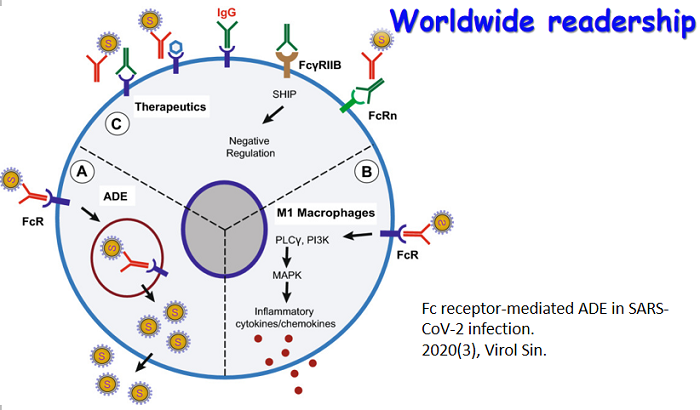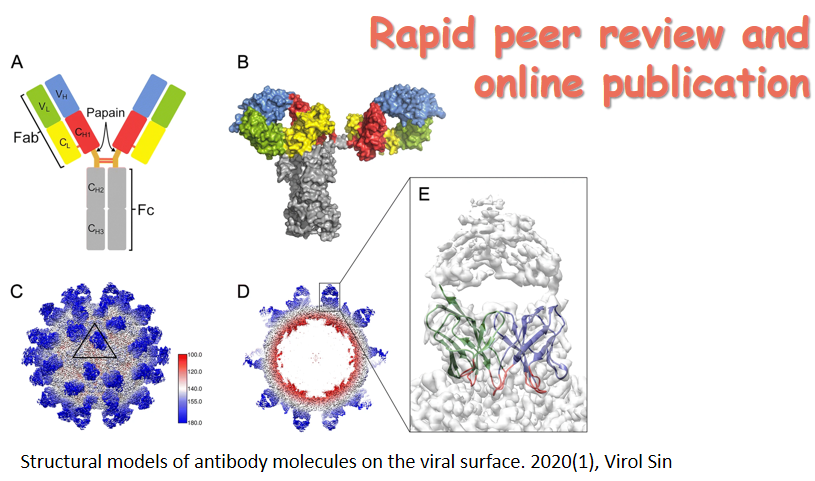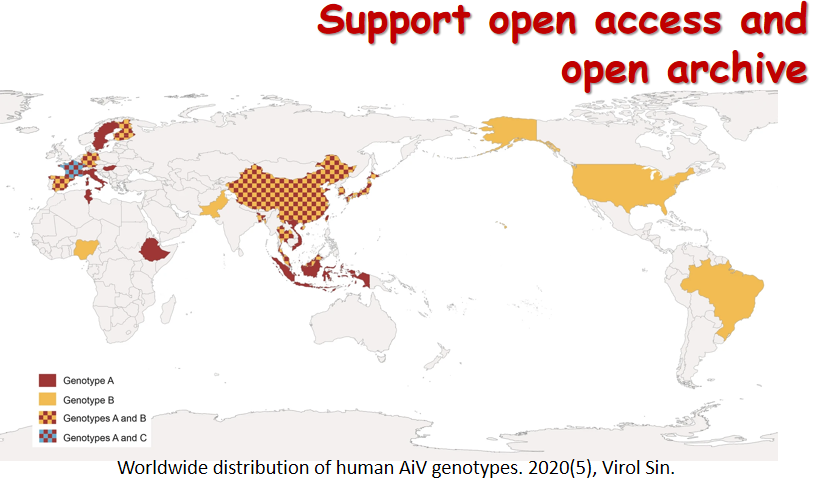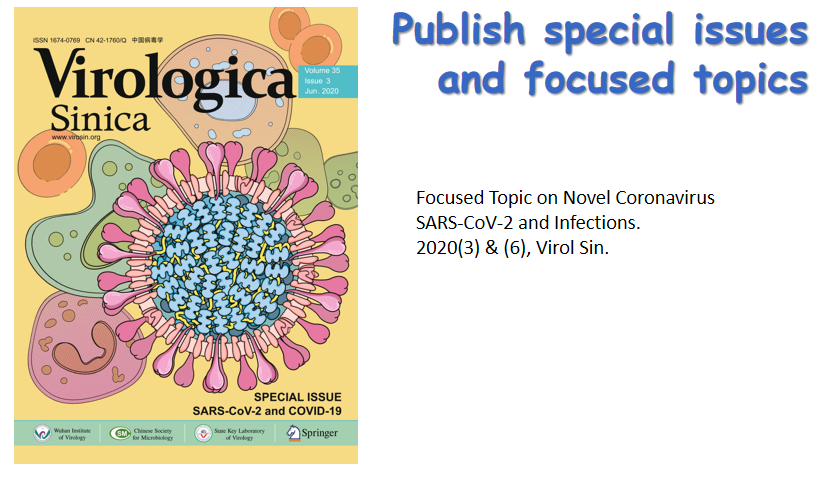Viral infection in human induces various levels of host immune response, through which the host aims to eliminate those intruders. However, some viruses could often evade immune system and result in chronic infections. Almost 500 million people world-wide are chronically infected with hepatitis B and C viruses and human immune deficiency virus. Thus, a special issue focusing on the interaction of the host immune system with HBC, HCV, and HIV, and new immunomodulations of these chronic viral diseases is presented as the first issue of 2014 in Virologica Sinica. The cover depicts hepatitis C viruses approaching the B lymphocyte.
-

Construction of a chimeric hepatitis C virus replicon based on a strain isolated from a chronic hepatitis C patient
2014, 29(1): 61 doi: 10.1007/s12250-014-3408-z
Received: 15 November 2013 Accepted: 10 January 2014 Published: 20 January 2014Subgenomic replicons of hepatitis C virus (HCV) have been widely used for studying HCV replication. Here, we report a new subgenomic replicon based on a strain isolated from a chronically infected patient. The coding sequence of HCV was recovered from a Chinese chronic hepatitis C patient displaying high serum HCV copy numbers. A consensus sequence designated as CCH strain was constructed based on the sequences of five clones and this was classified by sequence alignment as belonging to genotype 2a. The subgenomic replicon of CCH was replication-deficient in cell culture, due to dysfunctions in NS3 and NS5B. Various JFH1/CCH chimeric replicons were constructed, and specific mutations were introduced. The introduction of mutations could partially restore the replication of chimeric replicons. A replication-competent chimeric construct was finally obtained by the introduction of NS3 from JFH1 into the backbone of the CCH strain. -

The phenotype and activation status of regulatory T cells during Friend retrovirus infection
2014, 29(1): 48 doi: 10.1007/s12250-014-3396-z
Received: 18 October 2013 Accepted: 03 January 2014 Published: 20 January 2014The suppressive capacity of regulatory T cells (Tregs) has been extensively studied and is well established for many diseases. The expansion, accumulation, and activation of Tregs in viral infections are of major interest in order to find ways to alter Treg functions for therapeutic benefit. Tregs are able to dampen effector T cell responses to viral infections and thereby contribute to the establishment of a chronic infection. In the Friend retrovirus (FV) mouse model, Tregs are known to expand in all infected organs. To better understand the characteristics of these Treg populations, their phenotype was analyzed in detail. During acute FV-infection, Tregs became activated in the spleen and bone marrow, as indicated by various T cell activation markers, such as CD43 and CD103. Interestingly, Tregs in the bone marrow, which contains the highest viral loads during acute infection, displayed greater levels of activation than Tregs from the spleen. Treg expansion was driven by proliferation but no FV-specific Tregs could be detected. Activated Tregs in FV-infection did not produce Granzyme B (GzmB) or tumor necrosis factor α (TNFα), which are thought to be a potential mechanism for their suppressive activity. Furthermore, Tregs expressed inhibitory markers, such as TIM3, PD-1 and PD-L1. Blocking TIM3 and PD-L1 with antibodies during chronic FV-infection increased the numbers of activated Tregs. These data may have important implications for the understanding of Treg functions during chronic viral infections. -

Differential selection in HIV-1 gp120 between subtype B and East Asian variant B'
2014, 29(1): 40 doi: 10.1007/s12250-014-3389-y
Received: 06 October 2013 Accepted: 20 November 2013 Published: 16 January 2014HIV-1 evolves strongly and undergoes geographic differentiation as it spreads in diverse host populations around the world. For instance, distinct genomic backgrounds can be observed between the pandemic subtype B, prevalent in Europe and North-America, and its offspring clade B' in East Asia. Here we ask whether this differentiation affects the selection pressure experienced by the virus. To answer this question we evaluate selection pressure on the HIV-1 envelope protein gp120 at the level of individual codons using a simple and fast estimation method based on the ratio ka/ks of amino acid changes to synonymous changes. To validate the approach we compare results to those from a state-of-the-art mixed-effect method. The agreement is acceptable, but the analysis also demonstrates some limitations of the simpler approach. Further, we find similar distributions of codons under stabilizing and directional selection pressure in gp120 for subtypes B and B' with more directional selection pressure in variable loops and more stabilizing selection in the constant regions. Focusing on codons with increased ka/ks values in B', we show that these codons are scattered over the whole of gp120, with remarkable clusters of higher density in regions flanking the variable loops. We identify a significant statistical association of glycosylation sites and codons with increased ka/ks values. -

Calcium phosphate nanoparticles show an effective activation of the innate immune response in vitro and in vivo after functionalization with flagellin
2014, 29(1): 33 doi: 10.1007/s12250-014-3379-0
Received: 17 September 2013 Accepted: 19 November 2013 Published: 26 December 2013For subunit vaccines, adjuvants play a key role in shaping the magnitude, persistence and form of targeted antigen-specific immune response. Flagellin is a potent immune activator by bridging innate inflammatory responses and adaptive immunity and an adjuvant candidate for clinical application. Calcium phosphate nanoparticles are efficient carriers for different biomolecules like DNA, RNA, peptides and proteins. Flagellin-functionalized calcium phosphate nanoparticles were prepared and their immunostimulatory effect on the innate immune system, i.e. the cytokine production, was studied. They induced the production of the proinflammatory cytokines IL-8 (Caco-2 cells) and IL-1β (bone marrow-derived macrophages; BMDM) in vitro and IL-6 in vivo after intraperitoneal injection in mice. The immunostimulation was more pronounced than with free flagellin. -
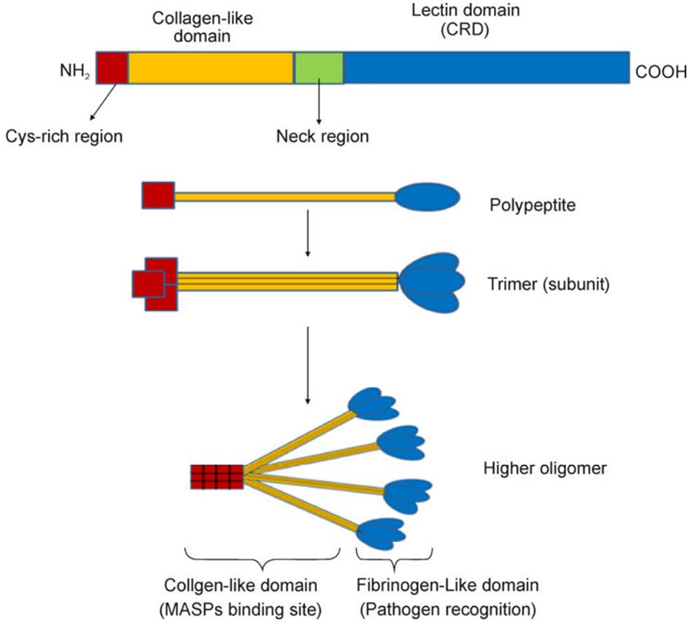
Ficolins and infectious diseases
2014, 29(1): 25 doi: 10.1007/s12250-014-3421-2
Received: 06 December 2013 Accepted: 16 January 2014 Published: 21 January 2014Ficolins are serum complement lectins, with a structure similar to mannose-binding lectin (MBL) and lung surfactant protein (SP)-A and SP-D. Ficolins activate the lectin complement system and play important roles in host innate immunity. Ficolins are members of the collectin family of proteins, which act as pattern recognition receptors (PRRs). They are soluble oligomeric defense proteins with lectin-like activity, and are able to recognize pathogen-associated molecular patterns (PAMPs), which are carbohydrate molecules on the surface of pathogens, and of apoptotic, necrotic, and malignant cells. Upon binding to their specific PAMPs, ficolins may trigger activation of the immune system either (1) by initiating activation of complement via the lectin pathway, (2) by a primitive type of opsonophagocytosis, or (3) by stimulating secretion of the inflammatory cytokines interferon (IFN)-γ, interleukin (IL)-17, IL-6, and tumor necrosis factor (TNF)-α, and production of nitric oxide (NO) by macrophages, thus limiting the infection and concurrently orchestrating the subsequent adaptive immune response. Recently, a number of reports have shown that dysfunction or abnormal expression of ficolins may play crucial roles in viral and bacterial diseases and in inflammation. This review summarizes the reports on the roles of ficolins in the infectious diseases, and provides insight into ficolins as novel innate immune therapeutic options to treat these diseases. -

Interplay between hepatitis B virus and the innate immune responses: implications for new therapeutic strategies
2014, 29(1): 17 doi: 10.1007/s12250-014-3412-3
Received: 27 November 2013 Accepted: 06 January 2014 Published: 20 January 2014Hepatitis B virus (HBV) infection is still a worldwide health problem; however, the current antiviral therapies for chronic hepatitis B are limited in efficacy. The outcome of HBV infection is thought to be the result of complex interactions between the HBV and the host immune system. While the role of the adaptive immune responses in the resolution of HBV infection has been well characterized, the contribution of innate immune mechanisms remains elusive until recent evidence implicates that HBV appears to activate the innate immune response and this response is important for controlling HBV infection. Here, we review our current understanding of innate immune responses to HBV infection and the multifaceted evasion by the virus and discuss the potential strategies to combat chronic HBV infection via induction and restoration of host innate antiviral responses. -

New therapeutic vaccination strategies for the treatment of chronic hepatitis B
2014, 29(1): 10 doi: 10.1007/s12250-014-3410-5
Received: 21 December 2013 Accepted: 08 January 2014 Published: 17 January 2014Chronic hepatitis B virus (CHB) is currently treated with either interferon-based or nucleot(s)ide-based antiviral therapies. However, treatment with pegylated interferon alpha results in a durable antiviral response in only about 30% patients and is associated with side effects. Most patients receiving nucleot(s)ide analogue treatment do not establish long-term, durable control of infection and have rebounding viremia after cessation of therapy. Thus, novel therapy strategies are necessary to achieve the induction of potent and durable antiviral immune responses of the patients which can maintain long-term control of viral replication. Therapeutic vaccination of HBV carriers is a promising strategy for the control of hepatitis B. Here the authors review new therapeutic vaccination strategies to treat chronic hepatitis B which may be introduced for patient treatment in the future. -
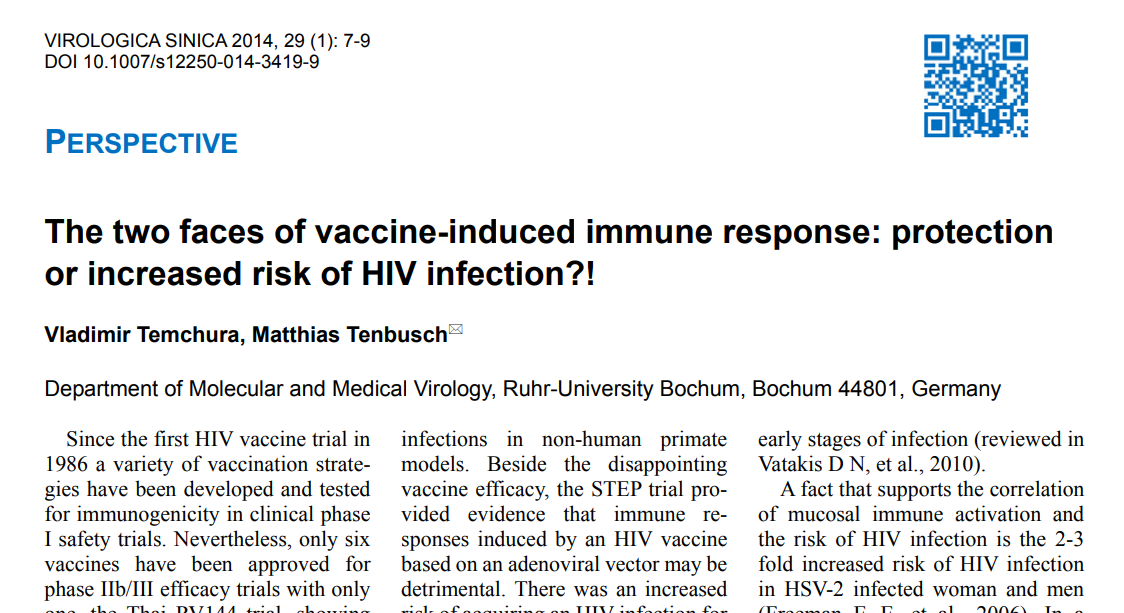
The two faces of vaccine-induced immune response: protection or increased risk of HIV infection?!
2014, 29(1): 7 doi: 10.1007/s12250-014-3419-9
Published: 21 January 2014 -
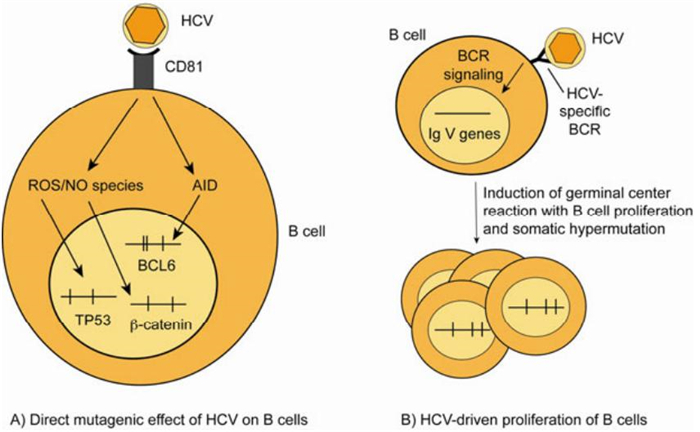
Role of hepatitis C virus in B cell lymphoproliferations
2014, 29(1): 3 doi: 10.1007/s12250-014-3414-1
Published: 20 January 2014 -
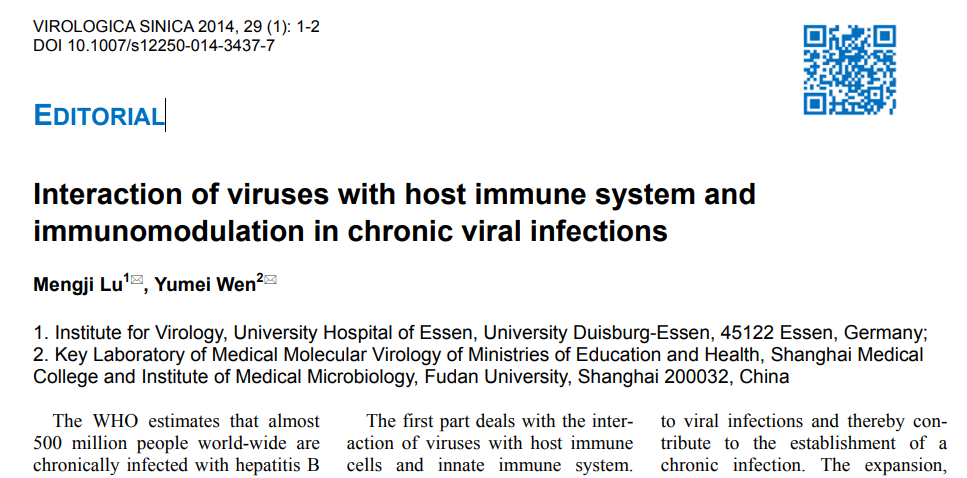
Interaction of viruses with host immune system and immunomodulation in chronic viral infections
2014, 29(1): 1 doi: 10.1007/s12250-014-3437-7
Published: 22 January 2014When you closely read the papers in this issue, you may find those researches are commonly founded by a so-called TRR60 program. The Transregional Collaboration Re-search Project (TRR) is a highly ranked program of German Research Foundation (DFG) to support the scientific competence with a strong focus on a specific research area. The joint German-Chinese TRR60 was firstly established by DFG in collaboration with the Ministry of Science and Technology (MOST) of China in 2009 and renewed by The National Science Foundation of China (NSFC) and DFG in 2013. The TRR60 recruited recognized scientists in the research field on viral infection and immunology from both countries. This research program is a result of the great effort of Chinese and German scientists, represents a milestone in the history of long standing and fruitful collaboration, and serves as a platform for active interaction and exchange.












